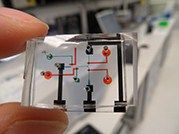
Tiny EEG Device Measures Brains Waves of Microscopic Worms (VIDEO)
One way to monitor the effects of psychoactive drugs is to use EEG (electroencephalography) to measure brain wave activity in the subjects studied.
Wed Jun 05 2013
One way to monitor the effects of psychoactive drugs is to use EEG (electroencephalography) to measure brain wave activity in the subjects studied. While this may work for primates and even rodents, many studies are conducted on small animals whose heads are much too tiny for traditional EEG caps or anything resembling them.
Caenorhadbitis elegans is a transparent nematode only about a millimeter in length that is a popular animal model of life science researchers. It has been studied by countless investigators in a variety of ways, but the little brains of nematodes are way too small for anything resembling what one would think of as EEG caps. So researchers at University of Southampton in the UK decided they’re going to build an EEG small enough so they could measure the effects of drugs on the little worms.
Some details and video of the technology:
The microfluidic invention consists of a reservoir through which worms can be fed, one after the other, into a narrow fluid-filled channel. The channel tapers at one end and this captures the worm by the front end. The worm is then in the correct orientation for recording the activity of the nervous system in the anterior of its body. The device incorporates metal electrodes, which are connected to an amplifier to make the recording. The design of the trapping channel has been optimised by PhD student Chunxiao Hu, so that the quality of the worm ‘EEG’ recording is sufficient to resolve the activity of components of the neural circuit in the worm’s nervous system.
Click here to watch the video.


